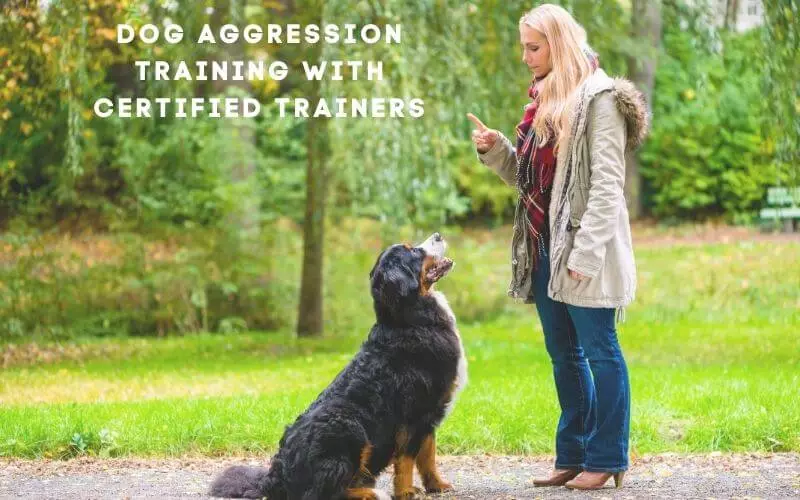Aggressive behaviors are always intimidating to people. When your dog shows signs of aggression simultaneously, it becomes a matter of concern. Most people claim dog aggression training is an excellent way to cure such unwanted behavior. However, we recommend diagnosing a dog’s aggression signs first.
To understand the symptoms of aggression in dogs, you need to observe the warning signs. When your dog starts to snarl, bark, or bite, it is a clear sign that he gets aggressive. You can also take his behavior seriously if seen any misbehaving nature towards other people or animals.
There are different types of aggressive dogs living around our neighborhood. But not all canines are that way out of poor socialization. Some may have developed their behavior due to past abuse, whereas others have underlying health complications or anxiety. Regardless of the causes, it is essential to take these symptoms seriously for choosing the best training program for these pups.
Dog Aggression Training Near Me – Is It The Right Time?
When is the best time to enroll your dog in a training program? It’s when you cannot handle his actions anymore.
There are times when you see your dog misbehaving way too much than ever before. And as days passed, his body language became much louder and more unexpected. Those are the day you realize it’s high time to get him under the supervision of a professional dog trainer.
A professional trainer knows how to train a dog without causing severe injuries. For instance, they know the correct use of prong collars. You can learn more about prong collars’ uses and abuses through this link.
So, you can consider keeping your dog under proficient training classes. At first, you can search for the nearest training center. A consultation with a veterinary behaviorist is also an option. They can suggest some aggression relief medications to cure mild aggression issues.
Types of Dog Aggression – Things You Need To Know
Aggressive behavioral factors may differ from dog to dog. It is precisely hard to classify what type of aggression behavior your dog is developing inside him unless you know the kinds. This segment brings upon the topmost common types of canine aggression that will help you identify your dog’s behavioral changes and show you a way to the recovery process.
Territorial Aggression
Some dogs are prone to believe that any outsider movement in your space or house is a sign of danger. They fear the strangers as an intruder with evil intentions. So, it alerts their aggressive nerve unless the owner assures them of no possible threat.
Protective Aggression
Dogs are pack animals, so they’re very protective of their family. Dogs protect their owners against any threat, and that’s what turns into aggression sometimes. This is primarily related to the symptoms of dominant aggression that mother dogs showcase towards their babies.
Possessive Aggression
Many dogs are possessive over their food, toys, and even areas in the house. But when they become over-possessive, such as biting or trying to inflict pain, you should consider those as possessive aggression.
Fear Aggression
Some dogs bite because they feel threatened and react aggressively to a threat. This type of aggression is considered fear-aggression. It’s almost like defensive aggression motivated by a desire to avoid something the dog perceives as threatening.
Social Aggression
Although dogs are supposed to be social animals, sometimes they are just not. Suppose your dog is not in touch with proper socialization or shows violent behaviors in a social situation. Then it is confirmed that your dog is walking towards the development of aggression.
Frustration-Elicited Aggression
At times, when you keep your dog restricted in a fenced yard, it might feel frustrated. Such frustration can lead to developing leash aggression or frustration-elicited aggression. So, be conscious of how you treat your dog.
Pain-Elicited Aggression
Dogs in pain, sick, or injured may become aggressive due to experiencing psychological damage. You should ensure that your dog is at peace whenever going through a painful or distressing experience.
Sex-Related Aggression
Male or female dogs are likely to get aggressive when they stay unattached from a partner for a long time. It is a very natural kind of aggression. However, owners can avoid such aggressive nature through spaying or neutering.
Predatory Aggression
You need to be careful when bringing a dog into the family, as some dogs show signs of aggression and predatory behavior towards children. Dogs usually manifest themselves as playing but could quickly turn serious — potentially leading to your dog biting your son or daughter.
How To Handle Dog Aggression
How to deal with dog aggression? What to do with an aggressive dog that bites? These are the queries we have encountered several times. It seems like this is something too challenging to deal with. Well, most probably, true, but not entirely.
Dogs can be a handful, but they can become perfect pets with patience and time. It’s essential to start your dog training early on so that both you and the dog can build up an affection for the other. If you’re ever worried about your dog getting aggressive with strangers or unfamiliar people, it’s best to consult an aggression expert. And love them!
You can also grab some of Amazon’s dog aggression supplies that impose positive reinforcement in dogs. We tried summing up quite a few numbers of products in the list. However, we couldn’t make it to that as only a few of these trusted products are claimed to bring rapid succession to the consumers.
Dog Aggression Training For Different Dog Breeds
Wrap Up
The trick to aggression training a dog is to remain assertive without being angry or nervous. According to several sources, dogs can detect human feelings and make decisions depending on their sentiments. So it’s important to control yourself and not give mixed signals.
To curtail a dog’s aggressive behaviors, dog owners need to prove that they control the situation. Owners should respond with action rather than words. This can mean walking away from the dog — and not looking back — to show him that this type of aggression can not be accepted.
It’s crucial to remember that a dog’s aggressive behavior could be due to fear. If your pet has become aggressive over time, it might be because you have been using too harsh methods. As a result, you have also been establishing fear, which could cause the pet to act aggressively as a means to defend itself.



